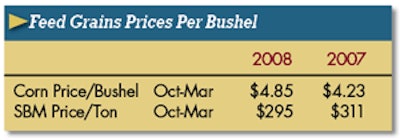
A world of rapid changes are affecting the energy-using industries. Since July 4, dramatic drops in fuel and feed costs have occurred. Corn prices fell $2.75 a bushel, soybean meal fell $100 a ton. Crude oil, heating oil and natural gas all tumbled hard. These lower costs to poultry feeders coincided with a fall of 7 cents per pound in wholesale broiler prices by late August.
These declines did not happen just because of over-extended trading in the futures market and reduced use of fuel by world consumers. The USDA reported in early August the world crops were better than earlier projections. For instance, U.S. corn yields were pushed up to 155 bushels per acre versus 148 last month. This put the crop at 12.28 billion bushels which could leave a comfortable ending stocks figure. Unless the corn crop gets considerably larger, I do not expect $3 corn in crop year 2008-2009. But I believe the highest price has occurred for the next several years. Inflation and growing demand for energy will keep coarse grain and soybean meal prices strong.
A decline in per capita meat supply in 2009 should buoy prices if the economy stays out of an official recession. Less meat production is expected by the beef, pork, broiler and turkey industries in the first six months of next year. If enough profit is accrued by broiler and turkey producers, further growth is likely by second half 2009. Very seldom have we experienced more than three quarters of lower meat supplies than a year earlier.
The broiler supply per capita includes a 2 percent increase in RTC weights versus a year ago. Fewer birds but bigger in size. The chicken industry has shown signs of slowing growth as its breeder flock in July is only 84 percent of the accumulated potential breeders placed versus 88.8 percent for the five-year average. It is also smaller than a year ago while utilization is 4 percent below the five-year average. This is more than just a seasonal decline; real production restraint is occurring. The U.S. broiler industry is responding to the high grain prices and relatively low meat prices in a resonable manner.
Economics is at work in this highly competitive industry.
















